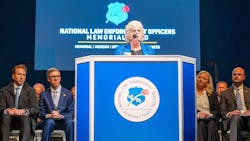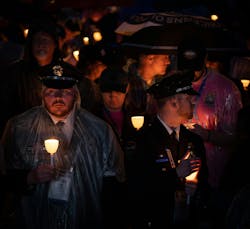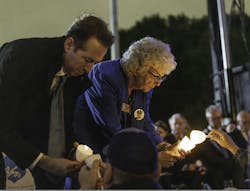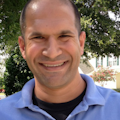Seasons of Grief: Widow Talks about Loss of Ohio Police Officer Husband
What to know
- This year's 37th Annual Candlelight Vigil honored 345 fallen officers, including 148 who died in the line of duty in 2024, with attendees braving rain to pay tribute on the National Mall.
- Connie Moyer, National COPS President, shared a powerful message on grief, resilience and remembrance, likening healing to the changing seasons.
- Attendees received flower seeds as a symbol of growth through grief, with a call to support one another and carry forward the light of fallen loved ones.
More on OFFICER.com
Download the May/June issue of OFFICER Magazine.
Click Here to subscribe to OFFICER Magazine.
In rainy conditions, the National Law Enforcement Officers Memorial Fund hosted the 37th Annual Candlelight Vigil on the National Mall on May 13 in Washington, D.C. The names of 345 federal, state, tribal and local law enforcement officers that were added to the memorial walls were read out loud in remembrance. Of those names, 148 of the officers died in the line-of-duty in 2024, while 197 died in previous years.
As the night began, Bill Alexander, CEO of the National Law Enforcement Officers Memorial Fund, addressed those in attendance. “Thank you for braving the elements with us tonight,” he told the crowd as the rain fell. “Law enforcement officers all across the country, and certainly your loved ones—our fallen heroes—did not stop working when it rained, and we on our part will not stop honoring these heroes even if the weather won’t cooperate.”
While the weather did make is difficult to carry out the annual lighting of the candles, those in attendance tried their best to do so and braved the conditions in order to honor the sacrifice that their loved ones paid.
Eight years ago, Lancaster, Ohio, Patrolman Scott Moyer died as the result of contracting an infectious disease. On Feb. 25, 1998, Moyer was backing up another officer trying to apprehend a resisting subject. The officer had to break a window to remove the man from his vehicle during a traffic stop as he attempted to flee the scene. Some of the glass became embedded in the man’s foot, causing lacerations. The man then pleaded with Moyer to help remove the glass. Moyer, who also had a cut on his hand, came in contact with the infected man’s blood, causing him to contract the infectious disease. He died on May 26, 2017, at the age of 66.
Connie Moyer, who is now the National President of Concerns of Police Survivors (COPS), spoke of her struggle following her husband’s death. “After my husband died, I found myself looking out the window one cold morning, staring at a tree in our neighbor’s yard. It was winter and it looked dead. Its branches were bare, the sky was gray, and I remember thinking, ‘That’s me; that’s what grief looks like.’ I remember wondering if I’d ever feel anything again. Sunshine, warmth, joy. If I’d ever laugh without feeling guilty. If I’d ever feel whole.”
Moyer compared the stages of grief to the seasons in a year, but stressed that they don’t change on a schedule, and can be different for different people. “One morning, months later, I saw the tiniest little bud on that tree; a hint of green. That didn’t mean that the pain had went away, it really never does. But it did mean that I was still here, still growing and still moving forward. Grief is like that. It comes in seasons. Some days feel like winter; bitter, isolating, dark. Other days feel like spring, when a memory brings a smile before it brings tears. Then there are summer days when you feel the warmth in your heart because someone spoke their name or you shared a story that made people laugh. And yes, we still have fall days when things shift, when we prepare ourselves for another wave of missing them. The seasons don’t erase one another, they build on each other, just like we do.”
As she looked on at the rain-soaked crowd on the National Mall, she conjured up the image of a forest of survivors, in which all of them were in different seasons of grief. “Some of you are fresh in your winter, your loss so recent that it takes your breath away. Others are beginning to see their first signs of spring. Some have found ways to live again, love again and laugh again. No matter what season that you’re in, please hear me when I say you are not alone. Look around you. These are your people, your blue family. These are the ones who will sit with you in the cold when your winter feels never ending, who will wrap you in a blanket with their love to keep the cold out, who will remind you that it’s OK to cry, and it’s OK to laugh.”
She said that survivors don’t heal by forgetting, they heal by remembering and learning how to carry their loved ones forward. “Scott was my husband for 40 years. Losing him felt like losing the sun in my sky. And then our daughter died. Just like each of you, my heart was broken into a million pieces. I didn’t think I could survive one loss, let alone two, but I did. I am able to stand here before you tonight, not because I’m strong, but because I wasn’t alone, because of my faith, because of my family, because of my friends and because of our organization Concerns of Police Survivors, but most importantly because I knew that to honor my husband and my daughter that I had to keep moving, to keep blooming. We all carry the weight of someone’s absence, but we also carry their light.”
Moyer told those in attendance that while she would pray that it would stop raining long enough to light the candles, that survivors should serve as a light for each other. “Let us hold space for the winters, let us celebrate the springs, let us bask in the warmth of summer and find strength in the transitions of fall. And most of all, let us never forget that just like the seasons, we still move forward.” Under the seats on the National Mall were bags of flower seeds, which she said were meant to be more than a gift. “They’re a reminder that growth often begins in darkness, beneath the soil in silence and unseen. But with time, with care and with love, something beautiful emerges. Plant them when you’re ready, when your heart is ready. There’s no rush, there’s no season more right than the one you’re in. And when they bloom, whenever that may be, let them remind you of the love that grows, the life that still surrounds you and the strength that still lives within you.”
“One of my very favorite events during National Police Week each year is this candlelight vigil. As we look up into the sky, we can rest assured that our loved ones are looking down upon us, proud of where we are and excited to see where we’re going.”
About the Author
Paul Peluso
Editor
Paul Peluso is the Managing Editor of OFFICER Magazine and has been with the Officer Media Group since 2006. He began as an Associate Editor, writing and editing content for Officer.com. Previously, Paul worked as a reporter for several newspapers in the suburbs of Baltimore, MD.



